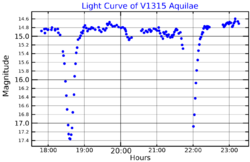Astronomy:V1315 Aquilae
 A light curve for V1315 Aquilae, from data taken on 31 August 2004. Adapted from Papadaki et al. (2009)[1] | |
| Observation data Equinox J2000.0]] (ICRS) | |
|---|---|
| Constellation | Aquila |
| Right ascension | 19h 13m 54.531s |
| Declination | +12° 18′ 03.238″ |
| Apparent magnitude (V) | 13.8[2] |
| Astrometry | |
| Radial velocity (Rv) | 38[3] km/s |
| Proper motion (μ) | RA: -2.381[3] mas/yr Dec.: -6.360[3] mas/yr |
| Parallax (π) | 2.2295 ± 0.0314[3] mas |
| Distance | 1,460 ± 20 ly (449 ± 6 pc) |
| Orbit | |
| Period (P) | 201 min[4] |
| Inclination (i) | 78.2[2]° |
| Other designations | |
V1315 Aql, 2MASS J19135453+1218033, CSV 8130 | |
| Database references | |
| SIMBAD | data |
V1315 Aquilae is a cataclysmic variable star in the north of the equatorial constellation of Aquila. It is in the sub-set of nova-like (NL) variables,[5] specifically a SW Sextantis star (a type of white dwarf-donor star pair).[6][7] These were characterized as having non-magnetic white dwarfs – thus that do not undergo dwarf-nova bright luminations ("eruptions").[5] There is countering evidence for some magnetism.[8][9] Being a SW Sextantis star, V1315 Aquilae has a high rate of mass transfer, so it is in steady-state accretion and in a constant state of outburst.[10] It emits most of its light in the visible range, and this comes from the accretion disk.[10] The eclipse depth is 1.8 mag.[11] No description of the donor star is made.
Nova shell
V1315 Aquilae has a roughly spherical shell of material around it with a maximal 1×10−5 solar masses (1⁄10000 M☉), which is too small to be any starburst nebula or more advanced supernova remnant. It is consistent with models of a remnant of a nova-scale eruption roughly 500 to 1200 years old (that is, plus the time for the light from this system to travel to the Earth). V1315 Aquilae is the first nova-like system to have been discovered with a nova shell.[5]
References
- ↑ Papadaki, C.; Boffin, H. M. J.; Stanishev, V.; Boumis, P.; Akras, S.; Sterken, C. (May 2009). "Photometric study of selected cataclysmic variables II. Time-series photometry of nine systems". The Journal of Astronomical Data 15: 1. Bibcode: 2009JAD....15....1P. https://ui.adsabs.harvard.edu/abs/2009JAD....15....1P. Retrieved 20 October 2021.
- ↑ 2.0 2.1 Szkody, P. (1987-02-01). "A photometric and spectroscopic comparison of the cataclysmic variables on the 2 sides of the period gap and at a specific orbital period". Astrophysics and Space Science 130 (1–2): 69–73. doi:10.1007/BF00654973. ISSN 0004-640X. Bibcode: 1987Ap&SS.130...69S.
- ↑ 3.0 3.1 3.2 3.3 Bailer-Jones, C. a. L.; Babusiaux, C.; de Bruijne, J. H. J.; Prusti, T.; Vallenari, A.; Brown, A. G. A.; Collaboration, Gaia (2018-04-25). "Gaia Data Release 2. Summary of the contents and survey properties" (in en). Astronomy and Astrophysics 616: A1. doi:10.1051/0004-6361/201833051. Bibcode: 2018A&A...616A...1G.
- ↑ Szkody, Paula; Piche, Francois (1990-09-01). "The phase 0.5 absorption in V1315 Aquilae, SW Sextantis, and DW Ursae Majoris". The Astrophysical Journal 361: 235–243. doi:10.1086/169188. ISSN 0004-637X. Bibcode: 1990ApJ...361..235S.
- ↑ 5.0 5.1 5.2 Hallinan, G.; Littlefair, S. P.; Dhillon, V. S.; Sahman, D. I. (2018-04-16). "Discovery of an old nova shell surrounding the cataclysmic variable V1315 Aql" (in en). Monthly Notices of the Royal Astronomical Society 477 (4): 4483–4490. doi:10.1093/mnras/sty950. Bibcode: 2018MNRAS.477.4483S.
- ↑ Rutten, R. G. M.; Dhillon, V. S. (1995-06-21) (in en). Spectropolarimetry of the nova-like variable V1315 Aql. doi:10.1093/mnras/277.3.777. https://archive.org/details/arxiv-astro-ph9506111.
- ↑ Hoard, D. W.. "The Big List of SW-Sextantis Stars". https://www.dwhoard.com/biglist.
- ↑ Steeghs, D.; Hakala, P.; Martinez-Pais, I. G.; Casares, J.; Rodriguez-Gil, P. (2000-11-15) (in en). Evidence of magnetic accretion in an SW Sex star: discovery of variable circular polarization in LS Pegasi. doi:10.1086/318922. https://archive.org/details/arxiv-astro-ph0011296.
- ↑ Hoard, D. H.. "The Magnetic Scenario for the SW-Sextantis Stars". https://www.dwhoard.com/biglist/magnetic.
- ↑ 10.0 10.1 Rutten, R. G. M.; van Paradijs, J.; Tinbergen, J. (1992-07-01). "Reconstruction of the accretion disk in six cataclysmic variable stars". Astronomy and Astrophysics 260: 213–226. ISSN 0004-6361. Bibcode: 1992A&A...260..213R.
- ↑ Szkody, Paula (1987-10-01). "Time-resolved IUE studies of cataclysmic variables. I - Eclipsing systems IP Peg, PG 1030+590, and V1315 AQL". The Astronomical Journal 94: 1055–1061. doi:10.1086/114540. ISSN 0004-6256. Bibcode: 1987AJ.....94.1055S.
 |

